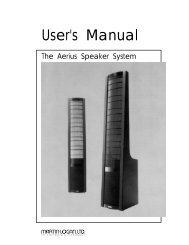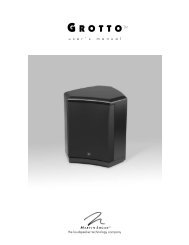M o n t i s - MartinLogan
M o n t i s - MartinLogan
M o n t i s - MartinLogan
You also want an ePaper? Increase the reach of your titles
YUMPU automatically turns print PDFs into web optimized ePapers that Google loves.
Room AcousticsYour RoomThis is one of those areas that requires both a little backgroundto understand and some time and experimentation to obtainthe best performance from your system. Your room is actuallya component and an important part of your system. This componentis a very large variable and can dramatically add to, orsubtract from, a great musical experience.All sound is composed of waves. Each note has its own wavesize, with the lower bass notes literally encompassing from 10’feet to as much as 40’ feet. Your room participates in this waveexperience like a three dimensional pool with waves reflectingand becoming enhanced depending on the size of the roomand the types of surfaces in the room.Remember, your system can literally generate all of the informationrequired to recreate a musical event in time, space, andtonal balance. Ideally, your room should not contribute to thatinformation. However, every room contributes to the sound tosome degree. Fortunately <strong>MartinLogan</strong> had designed the Montisto minimize these anomaliesLet’s talk about a few important terms before we begin.TerminologyStanding WavesThe parallel walls in your room will reinforce certain notes tothe point that they will sound louder than the rest of the audiospectrum and cause “one note bass”, “boomy bass” or “bloatedbass”. For instance, 100Hz represents a 10 feet wavelength. Yourroom will reinforce that specific frequency if one of the dominantdimensions is 10 feet. Large objects in the room such ascabinetry or furniture can help to minimize this potential problem.Some serious “audiophiles” will literally build a specialroom with no parallel walls just to help eliminate this phenomenon.Reflective Surfaces (near-field reflections)The hard surfaces of your room, particularly if close to yourspeaker system, will reflect some waves back into the room overand over again, confusing the clarity and imaging of your system.The smaller sound waves are mostly affected here, and occur inthe mid and high frequencies. This is where voice and frequenciesas high as the cymbals occur.Resonant Surfaces and ObjectsAll of the surfaces and objects in your room are subject tothe frequencies generated by your system. Much like aninstrument, they will vibrate and “carry on” in syncopationwith the music, and contribute in a negative way to themusic. Ringing, boominess, and even brightness can occursimply because they are “singing along” with your music.Resonant CavitiesSmall alcoves or closet type areas in your room can be chambersthat create their own “standing waves” and can drum their own“one note” sounds.Clap your hands. Can you hear an instant echo respond back?You have near-field reflections. Stomp your foot on the floor.Can you hear a “boom”? You have standing waves or large panelresonances such as a poorly supported wall. Put your head ina small cavity area and talk loudly. Can you hear a booming?You’ve just experienced a cavity resonance.Rules of ThumbHard vs. Soft SurfacesIf the front or back wall of your listening room is soft, it mightbenefit you to have a hard or reflective wall in opposition. Theceiling and floor should follow the same basic guideline as well.However, the side walls should be roughly the same in order todeliver a focused image.This rule suggests that a little reflection is good. As a matter offact, some rooms can be so “over damped” with carpeting,drapes and sound absorbers that the music system can sounddull and lifeless. On the other hand, rooms can be so hard thatthe system can sound like a gymnasium with too much reflectionand brightness. The point is that balance is the optimum environment.Breakup ObjectsObjects with complex shapes, such as bookshelves, cabinetryand multiple shaped walls can help break up those sonic gremlinsand diffuse any dominant frequencies.Solid CouplingYour loudspeaker system generates frequency vibrations orwaves into the room. This is how it creates sound. These vibrationsvary from 20 per second to 20,000 per second. If yourspeaker system is not securely planted on the floor or solid surface,it can shake as it produces sound and, consequently, thesound can be compromised. If your speaker is sitting on the carpetand only foot gliders are used, the bass can be ill definedand even boomy. The use of spikes is recommended to insuresecured footing for your speakers. (See ‘Solid Footing’ for spikeinformation and installation instructions).EnglishRoom Acoustics 27






